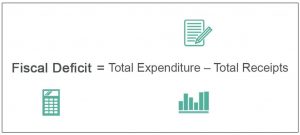The much-awaited Budget 2022 is out, and there has been an increase in the number of “thoughtful” policies agenda for India. Budget 2022 brings with it a sense of optimism, reflecting the Government’s continued focus on ‘Make in India’ and thereby decreasing the dependency on imports. This year’s budget is a step in the right direction to lead India towards an Atma Nirbhar Bharat in its true sense.
In this article, we will try to understand its impact on the Bond Market and its investors.
A. The Union Budget pegged the budgeted gross market borrowing number for the next fiscal year at Rs 14,95,000 cr.
It was expected to be Rs. 12,00,000 cr to 13,00,000 cr by market experts. This huge borrowing is because the Government’s capital expenditure* is showing an increase of 35% YoY from FY22, which was at Rs. 5,54,000 cr, to Rs. 7,50,000 cr for FY 23. More expenditure means more borrowing.
Incidentally, this expense is 2.9% of GDP ( India’s GDP for 2020-21 : Rs 19,745,670 cr)
*Capital Expenditure – Money spent by an entity to acquire, develop or improvise assets like land, buildings, equipment, furnishing, etc.
What does this mean for all of us?
According to this report, the Government will borrow from the market by issuing more sovereign bonds called Government Securities – aka GSecs.
This unexpected increase in GSec supply will increase the GSec yields sharply.
Let us explain how this will happen
We will analyze this by using Economics 1-0-1: The principle of Demand and Supply.
When a commodity has more supply than the demand in the market, its price drops. In the context of the budget, the Government will be issuing more Gsecs into the market to borrow money. This increased supply will cause existing GSec prices to drop.
Now, for bonds, price and yield are inversely correlated. So, with a drop in GSec prices, their yields spike up. This also means that the new GSec issues will bear higher coupon rates than the current ones. (In order to be lucrative for buyers/ investors)
Summary
More bond issuance → More bond supply in market → Price of existing bonds will drop → Yields of existing bonds will increase → New bonds issued will bear higher coupon rates to match high yields in the market.
To know the difference between Coupon and Yield of a bond, please read
8 Terminologies You Must Know Before You Invest in Bonds
B. According to this year’s budget, the Fiscal deficit** for FY22 is also higher than what was budgeted for.
The fiscal deficit currently stands at 6.9%, whereas the budgeted percentage stands at 6.4%(2022-23).

**Fiscal Deficit – When a Government’s yearly earnings are less than its yearly expenditure, it is called a fiscal deficit. It is an absolute term and is represented as the percentage of Gross domestic product (GDP).
What does this mean for all of us?
An increase in the fiscal deficit plays a major role in the exchange price of the Rupee currency. As the fiscal deficit is inversely proportional to the exchange value of the Rupee, an increase in the fiscal deficit will depreciate the value of the Rupee.
The government has to start issuing new bonds to raise extra money to fill up the deficit. More bond issuances mean bond prices will drop, and yields will increase.
What else can happen due to this?
- When the coupon rates over the newly issued GSecs keep increasing, it also affects the secondary market for Corporate Debentures. Outstanding corporate debentures generally offer an extra delta over the GSec returns/ yields. This is because they are perceived to be a level higher in risk scale (based on credit ratings ) than the GSecs. So they pay the extra returns/ yields to compensate for the risk level.
- To a large extent, if the fiscal deficit keeps increasing, it affects the country’s creditworthiness. Rating agencies will downgrade the credit ratings of India. Theoretically, this can lead to lower investments in our sovereign bonds from investors all around the world.
Summary
Increasing fiscal deficit → more bond issuance to raise funds to make up the deficit.
More bond issuance → More supply in market → Price of existing bonds drops → Yields of existing bonds increase → New bonds issued will bear higher coupon rates to match high yields in the market.
C. To bridge its fiscal deficit of 6.4 percent (2022-23) of the gross domestic product (GDP), the Government will also be tapping small savings of Rs 5,67,000 cr in the next fiscal, as against Rs 6,78,000 cr in the current fiscal.
What does this mean for all of us?
To fund India’s budget plan, the Government plans to utilize the small savings made by the citizens of the country. Now, interest paid on small savings by federal banks is around 8%, while the yield on Sovereign bonds of similar maturity i.e. 10 yrs, is around 6%.
Let’s discuss its impact on our investors who invest in bonds and debentures for their fixed-income investments:
- For new investors in the bond market, it is a beneficiary deal. New bond and debenture tranches can offer more coupon rates than the existing bonds already there in the market. The secondary market bonds’ prices will go down, offering higher yields.
- For existing investors, it might be a tricky deal. As bond prices go down, their existing bond investments will decrease in notional value. Say, an investor has purchased a bond at a price of 100. Before the budget announcement, its price in the secondary market was 103. Now post-budget, it might have been revised to 102. So this investor will reap lesser capital gains if he sells now.
For another investor, say he purchased a bond at 103. Now, as the price is at 102, he will incur a capital loss if he tries to sell this. Investors like him can mitigate this risk fully by adopting the time-tested strategy: Hold till Maturity.
Summary
As the interest payable by the Government on small savings deposits is higher, to ease this, banks may need to cut deposit and correspondingly lending rates too. Lower deposit rates on small savings will lower people’s eagerness to invest here. So consequently, banks will have a lower quantum of funds to lend out. Lowered lending levels can hinder the fund flow into the overall economy.
D. The Union budget mentions that the Government will be issuing sovereign Green bonds as part of its overall market borrowings in 2022-23 which will help in mobilizing resources for green infrastructure.
Also, the proceeds will be deployed in public sector projects that will help in reducing the economy’s carbon intensity.
This is a progressive step towards financing the green energy transformation of our nation.

Firstly, let’s understand what do Green bonds mean?
As the name suggests, Green bonds are used to raise funds to finance green initiatives such as clean energy generation, building sustainable environment-friendly energy infrastructure etc. It’s a popular concept in developed nations, and India is fast catching up on such progressive moves.
Summary
- Due to new issuances, there will be more supply of bonds in the market. With consistent demand, the prices of the existing bonds will fall, whereas the yields of existing bonds will rise. This will make it necessary for new issuances to be issued at higher coupon rates to match the existing high yields of the bonds.
- The increase in the coupon rates of Gsecs would also affect the operations in the secondary market. As corporate bonds are riskier than Gsecs, they provide extra yield over their bonds. This happens to compensate an investor who is bearing more risk.
- New Gsec can have a higher coupon rate.
Conclusion
The budget is inclusive and focused on the sustainable development of a climate-adaptive and resilient Indian economy. Industry participants, meanwhile, have welcomed the government announcement, which, they believe, will help India transition towards a carbon-neutral economy. This budget proposes several near-term and long-term actions accordingly, opening up huge employment opportunities and taking the country on a sustainable development path.
That’s all for now from our Research desk @ GoldenPi ! Happy reading…






